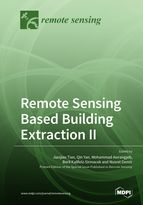Remote Sensing Based Building Extraction II
A special issue of Remote Sensing (ISSN 2072-4292). This special issue belongs to the section "Urban Remote Sensing".
Deadline for manuscript submissions: closed (30 June 2022) | Viewed by 44054
Special Issue Editors
Interests: forest remote sensing building extraction; 2D/3D change detection; data fusion; time-series image analysis; semantic 3D point cloud segmentation; computer vision; 3D reconstruction
Special Issues, Collections and Topics in MDPI journals
Interests: photogrammetry; remote sensing information extraction; natural resource monitoring; building extraction; data fusion
Interests: deep learning; remote sensing image processing; point cloud processing; change detection; object recognition; object modelling; remote sensing data registration; remote sensing of environment
Special Issues, Collections and Topics in MDPI journals
Interests: remote sensing; computer vision; AI/XAI; urban region monitoring; climate adaptation
Special Issues, Collections and Topics in MDPI journals
Interests: LIDAR; RADAR/SAR; building detection; 3D reconstruction; image analysis; point cloud processing; machine learning; earth observation; capacity building orest remote sensing building extraction; 2D/3D change detection; data fusion; time-series image analysis; semantic 3D point cloud segmentation; computer vision
Special Issues, Collections and Topics in MDPI journals
Special Issue Information
Dear Colleagues,
Building extraction from remote sensing data plays an important role in urban planning, disaster management, navigation, updating geographic databases, and several other geospatial applications. The rapid development of image processing techniques and easily available very-high-resolution multispectral, hyperspectral, LiDAR, and SAR remote sensing images have further boosted the research on building-extraction-related topics. Especially, in recent years, many research institutes and associations have provided open source datasets and annotated training data to meet the demand of advanced artificial intelligence models, which brings new opportunities to develop advanced approaches for building extraction and monitoring.
Hence, there are higher expectations on the efficiency, accuracy, and robustness of building extraction approaches. They should also meet the demand of processing large datasets at city, national, and global scale. Moreover, challenges remain on transform learning and dealing with imperfect training data, as well as unexpected objects in urban scenes such as trees, cloud, and shadows. Along with the building masks, more research arises to generate LoD2/3 building models from remote sensing data automatically.
The previous Special Issue ‘Remote Sensing based Building Extraction’ was a great success. This Special Issue aims to investigate the cutting-edge methodology and applications related to one or more of the following topics,
- Advanced AI models for building detection and extraction;
- Semantic remote sensing image segmentation;
- 2D/3D change detection;
- Disaster monitoring;
- Rooftop modelling from remotely sensed data;
- 3D point cloud segmentation;
- Building boundary extraction and vectorization;
- Large scale urban growth monitoring;
- Weakly supervised urban classification;
- Time-series remote sensing data analysis;
- Roof-top modelling;
- Urban object (vehicle, road, etc.) detection;
- Multi-sensor, multi-resolution, and multi-modality data fusion;
- Climate adaptation of smart cities;
- Sustainable development.
Dr. Jiaojiao Tian
Prof. Dr. Qin Yan
Dr. Mohammad Awrangjeb
Dr. Beril Kallfelz-Sirmacek
Dr. Nusret Demir
Guest Editors
Manuscript Submission Information
Manuscripts should be submitted online at www.mdpi.com by registering and logging in to this website. Once you are registered, click here to go to the submission form. Manuscripts can be submitted until the deadline. All submissions that pass pre-check are peer-reviewed. Accepted papers will be published continuously in the journal (as soon as accepted) and will be listed together on the special issue website. Research articles, review articles as well as short communications are invited. For planned papers, a title and short abstract (about 100 words) can be sent to the Editorial Office for announcement on this website.
Submitted manuscripts should not have been published previously, nor be under consideration for publication elsewhere (except conference proceedings papers). All manuscripts are thoroughly refereed through a single-blind peer-review process. A guide for authors and other relevant information for submission of manuscripts is available on the Instructions for Authors page. Remote Sensing is an international peer-reviewed open access semimonthly journal published by MDPI.
Please visit the Instructions for Authors page before submitting a manuscript. The Article Processing Charge (APC) for publication in this open access journal is 2700 CHF (Swiss Francs). Submitted papers should be well formatted and use good English. Authors may use MDPI's English editing service prior to publication or during author revisions.
Keywords
- building extraction
- 3D urban modelling
- urban classification
- roof reconstruction
- building change detection
- large scale surveillance
- disaster monitoring
- LiDAR
- optical stereo imagery
- hyperspectral data
- SAR
- data fusion
- time-series monitoring
- climate adaptation
- sustainable development









